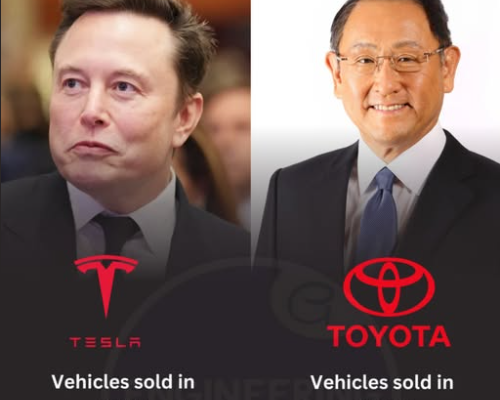Tesla
Tesla, Inc. is an American electric vehicle (EV) and clean energy company founded in 2003 by engineers Martin Eberhard and Marc Tarpenning, but it was Elon Musk, who joined the company as an investor in 2004, who later became its most prominent figure and CEO. Tesla is best known for its electric cars, which are widely considered some of the best in terms of performance, range, and technology. The company’s flagship vehicles include the Model S, Model 3, Model X, and Model Y.
Beyond EVs, Tesla has expanded into energy solutions, including solar products (like solar panels and Solar Roof) and energy storage systems (such as Powerwall). Tesla has been a major player in driving the EV revolution, with a focus on sustainability and reducing reliance on fossil fuels.
Some of the key innovations Tesla is known for include:
- Autopilot: Tesla’s advanced driver-assistance system, which offers semi-autonomous driving features.
- Supercharger Network: A network of fast-charging stations that allows Tesla vehicles to quickly charge their batteries across long distances.
- Gigafactories: Massive manufacturing plants designed to produce electric vehicles, batteries, and energy products at scale.
Toyota
Toyota Motor Corporation is a Japanese multinational automotive manufacturer founded in 1937 by Kiichiro Toyoda. It is one of the largest car manufacturers in the world and has a reputation for producing reliable, fuel-efficient vehicles. Toyota’s most notable models include the Corolla, Camry, Prius, and Land Cruiser.
Toyota was a pioneer in hybrid technology, launching the Prius, the world’s first mass-produced hybrid car, in 1997. The Prius became a global symbol of eco-friendly transportation and cemented Toyota’s position as a leader in green automotive technology.
In addition to hybrids, Toyota is investing heavily in electric vehicles and hydrogen fuel cell technology, aiming to stay at the forefront of the industry as the shift toward clean energy vehicles accelerates. Toyota’s focus has also been on:
- Hydrogen fuel cells: Toyota’s Mirai model is one of the world’s first hydrogen fuel-cell vehicles, offering an alternative to electric cars by using hydrogen to generate electricity.
- Robotics and AI: Toyota is involved in advanced robotics and artificial intelligence through its Toyota Research Institute, exploring ways to improve vehicle safety, mobility, and autonomous driving.
- Global presence: Toyota operates a vast manufacturing network around the world and is involved in various joint ventures in markets like the U.S., China, and Europe.
Key Differences Between Tesla and Toyota
- Innovation Focus: Tesla is often seen as the innovator in the electric vehicle space, pushing the boundaries of battery technology, self-driving systems, and fast charging. Toyota, on the other hand, is known for its hybrid technology, reliability, and focus on diversified energy solutions like hydrogen fuel cells.
- Electric Vehicle Adoption: Tesla’s main focus has been on 100% electric vehicles, whereas Toyota has traditionally offered both hybrids and is now expanding into full electric cars.
- Business Models: Tesla is a relatively new company in the automotive world but has revolutionized the industry with its direct-to-consumer sales model and innovative technology. Toyota is an established giant, known for its global manufacturing capabilities and extensive supply chain.
Both companies are pivotal players in the future of the automotive industry, each contributing in its own unique way to the ongoing shift towards more sustainable transportation solutions.
Tesla’s Financials
Tesla’s revenue primarily comes from the sale of electric vehicles, energy products (like solar panels and energy storage systems), and services related to its cars. As of recent years, Tesla has seen rapid revenue growth, driven by increasing demand for electric vehicles and expanding its production capacity.
Here’s a general breakdown of Tesla’s revenue sources:
- Electric Vehicles: The bulk of Tesla’s revenue comes from the sale of electric vehicles, particularly the Model 3 and Model Y, which have become the company’s best-sellers. The growth of Tesla’s car production and sales has been a key factor in its expanding revenue.
- Energy Generation and Storage: Tesla also generates revenue from its solar products and energy storage systems, such as the Powerwall, Powerpack, and Megapack. These products aim to accelerate the transition to renewable energy.
- Services and Other Revenue: Tesla generates additional revenue through after-sales services like maintenance, repair, and its software offerings (e.g., Autopilot upgrades and subscription services).
Tesla has posted increasing profits in recent years after a long period of operating at a loss. For example, in 2023, Tesla’s annual revenue was over $80 billion, with strong profits, mainly driven by vehicle sales and global expansion. Tesla’s stock price has surged significantly over the past few years, making it one of the most valuable automakers in the world.
Toyota’s Financials
Toyota is one of the largest car manufacturers globally and generates revenue from a diverse range of sources. Its financial strength is supported by a massive scale of operations and a broad product portfolio that spans from fuel-efficient compact cars to luxury vehicles and trucks.
Here’s a breakdown of Toyota’s main revenue streams:
- Vehicle Sales: Similar to Tesla, Toyota’s primary source of income comes from the sale of cars. However, Toyota’s portfolio is much broader, offering cars, trucks, SUVs, hybrids, and luxury vehicles under its Lexus brand. It is the largest automaker by volume and sells millions of vehicles each year globally.
- Financial Services: Toyota has a robust financial services division, which offers financing options to car buyers through Toyota Financial Services. This includes leasing and loan services, which contribute significantly to the company’s revenue.
- Parts and Components: Toyota also generates substantial revenue from selling auto parts, accessories, and components to other manufacturers. Additionally, Toyota has various joint ventures that further increase its income.
- Technology and Mobility Solutions: Toyota has been expanding its business into smart cities and mobility solutions. For example, Toyota’s Woven Planet division explores autonomous driving technology, robotics, and mobility-as-a-service platforms.
Toyota’s revenue is much larger than Tesla’s due to its extensive global reach, product variety, and decades of established operations. In recent years, Toyota’s revenue has been over $275 billion, with profits typically ranging from $20 billion to $30 billion annually, depending on market conditions.
Comparison in Terms of Revenue and Market Capitalization:
- Revenue: Toyota’s annual revenue is much larger than Tesla’s because of its long-established global presence and broader vehicle portfolio. In 2023, Toyota’s revenue was around $275 billion, compared to Tesla’s revenue of approximately $80 billion.
- Market Capitalization: Tesla’s market capitalization (value of all its shares) has often exceeded Toyota’s in recent years, reflecting investor optimism around its growth potential, especially in electric vehicles. Tesla’s stock price has risen dramatically, making it one of the highest-valued automakers globally. Tesla’s market cap can range around $800 billion to over $1 trillion, while Toyota’s market cap is typically in the range of $200 to $250 billion.
Key Differences in Revenue Models:
- Tesla focuses on electric vehicles and sustainable energy solutions, with much of its growth driven by its innovation in technology and increasing vehicle production.
- Toyota has a more diversified revenue base, with a strong focus on traditional vehicles, hybrids, luxury cars, financial services, and parts. It generates substantial income from its global manufacturing and sales network.
Both companies have different business models and growth strategies, but both play crucial roles in the automotive and energy industries.
Tesla (2014)
In 2014, Tesla was still a relatively young company and was expanding its production capacity and product offerings. Here are some key figures for Tesla’s financials in 2014:
- Revenue: Tesla generated approximately $3.2 billion in revenue in 2014, a significant increase from the previous year.
- Net Loss: Despite the growth in revenue, Tesla still posted a net loss of around $294 million for the year, as it was heavily investing in expanding its production and infrastructure.
- Vehicle Deliveries: Tesla delivered around 31,655 vehicles in 2014, primarily focusing on its Model S sedan.
- Stock Performance: Tesla’s stock price saw significant growth in 2014, reflecting investor confidence in its electric vehicle technology.
Toyota (2014)
Toyota, being a much larger and more established company, had much higher revenues and profits compared to Tesla in 2014:
- Revenue: Toyota generated approximately $240 billion in revenue in 2014, reflecting its massive global operations and vehicle sales.
- Net Income: Toyota posted a net income of about $17 billion in 2014, which was a strong result for the company.
- Vehicle Sales: Toyota sold around 10.2 million vehicles in 2014, solidifying its position as one of the world’s largest car manufacturers.
- Stock Performance: Toyota’s stock had a more stable performance, reflecting its well-established position in the market.
Summary
In 2014:
- Tesla had revenue of $3.2 billion and a net loss of $294 million.
- Toyota had revenue of $240 billion and net income of $17 billion.
Tesla, as a newer company focused on electric vehicles, had much smaller revenue figures but was growing rapidly, while Toyota, as one of the largest automakers in the world, had significantly higher revenue and profit.



